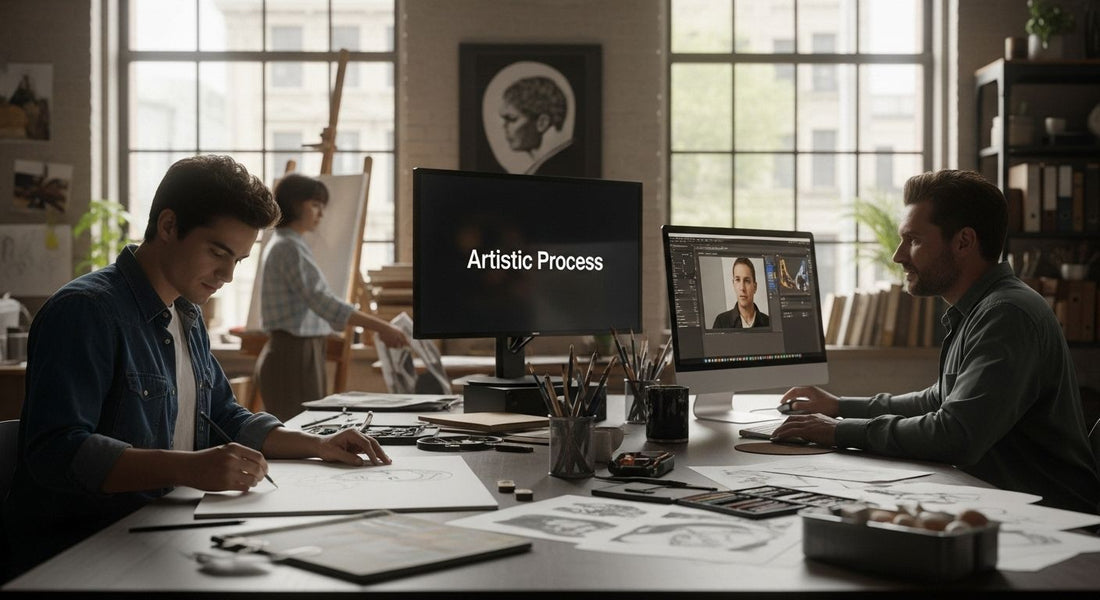
The Artistic Process Behind Canvases: Modern Inspiration 2025
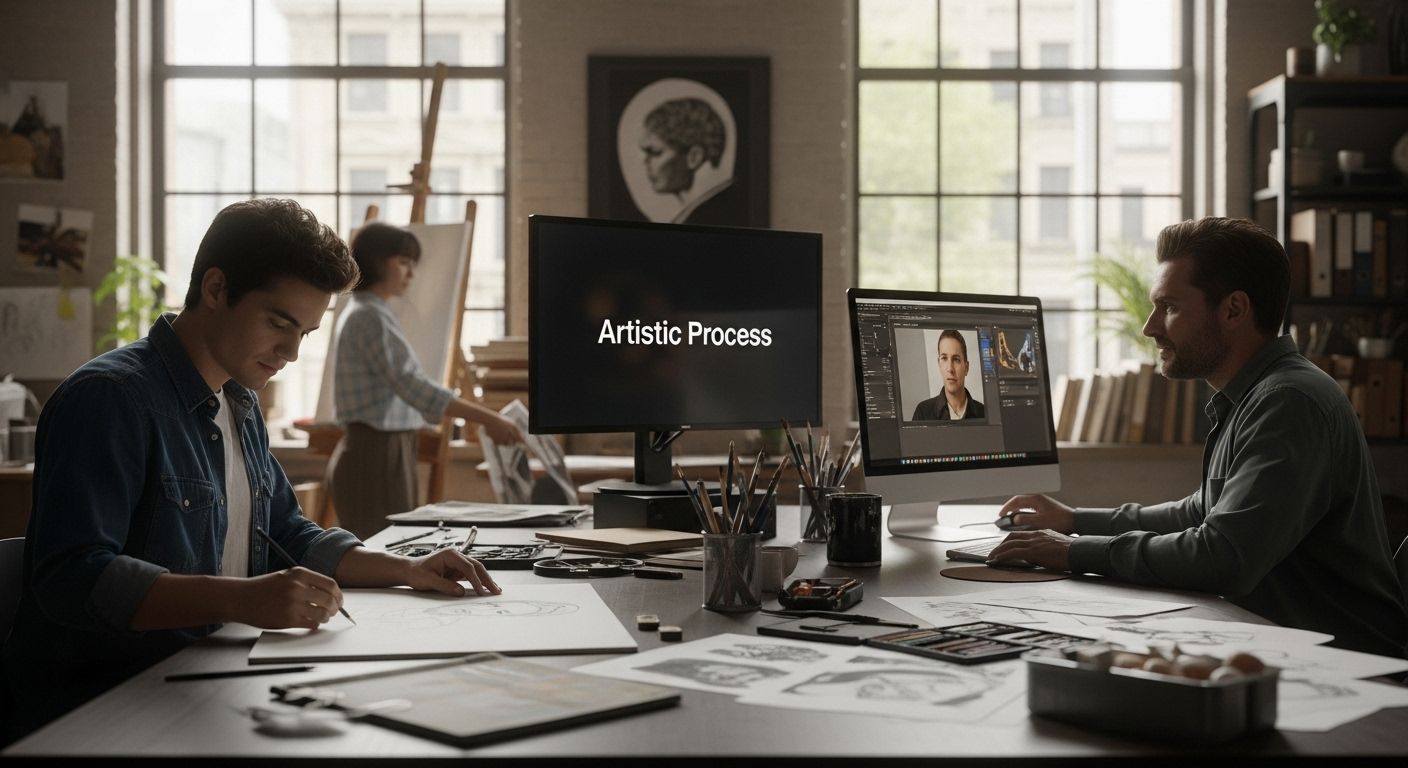
The way artists make modern canvas art is changing at a rapid pace. Studies show that exposure to art can actually encourage people to think more creatively and solve complex problems. Many assume that the most fascinating element of a painting is the image you see on the wall. But it turns out the real intrigue comes from the steps you never witness—the blend of new tech, surprising inspiration, and wild innovations that shape every piece long before the first brushstroke.
Table of Contents
- Exploring Inspiration For Canvas Art
- Step-By-Step Creation Of Modern Canvases
- Techniques Shaping Abstract And Luxury Prints
- How The Artistic Process Adds Value For Collectors
Quick Summary
| Takeaway | Explanation |
|---|---|
| Embrace Diverse Sources of Inspiration | Artists should explore unexpected experiences and cultural influences to spark creativity. |
| Utilize Modern Technology for Creation | Incorporating digital tools enhances conceptualization and material selection in canvas art. |
| Document the Artistic Process | The narrative behind a piece significantly impacts its value and appeal to collectors. |
| Prioritize Authenticity and Provenance | Genuine documentation of an artwork’s origins and creation enhances its cultural and economic value. |
| Understand Art as a Cultural Investment | Collectors should view artworks as part of a broader narrative, impacting historical and cultural contexts. |
Exploring Inspiration for Canvas Art
Artistic inspiration emerges from complex emotional and sensory experiences, transforming abstract thoughts into tangible visual narratives. The journey of creating canvas art represents a profound exploration of personal vision, cultural influences, and innovative techniques that push creative boundaries.
The Origins of Creative Spark
Artists often discover inspiration through unexpected encounters and deep personal reflections. Discover how art transforms creative spaces and understand the intricate mechanisms behind artistic motivation. According to a fascinating study in the Journal of Business Research, individuals with open attitudes toward aesthetic experiences are significantly more likely to generate creative solutions. This research reveals that exposure to art itself can stimulate creative thinking, suggesting that inspiration is not just a passive experience but an active engagement with visual narratives.
The creative process involves multiple interconnected stages that transform initial concepts into compelling visual expressions. Emotional resonance plays a critical role in this transformation, where personal experiences, memories, and sensory impressions become the raw material for artistic interpretation.
Psychological Dimensions of Artistic Inspiration
Understanding the psychological mechanisms behind artistic inspiration requires examining how artists translate internal experiences into visual language. According to research published in The Journal of Creative Behavior, the artistic process typically follows structured yet flexible stages: conceptualization, documentation, initial sketching, experimental form exploration, draft creation, and final composition.
These stages are not linear but dynamic, allowing artists to move fluidly between different phases of creative development. Intuitive connections emerge during this process, where seemingly unrelated experiences converge to create unique visual representations. An urban landscape, a fleeting emotional state, or a complex philosophical concept can suddenly crystallize into a compelling canvas artwork.
To clarify the dynamic and interconnected stages of the artistic process, the following table summarizes the key phases and their characteristics as described in this section:
| Stage | Description |
|---|---|
| Conceptualization | Developing initial ideas and creative vision |
| Documentation | Recording thoughts, inspiration, and potential themes |
| Initial Sketching | Exploring early visual arrangements through preliminary drawings |
| Experimental Form Exploration | Testing forms, structures, and compositions |
| Draft Creation | Developing more detailed iterations of the artwork |
| Final Composition | Completing the artwork into its finished visual state |
Technological and Cultural Influences
Modern artistic inspiration increasingly integrates technological advancements and global cultural exchanges. Contemporary artists draw inspiration from diverse sources: digital interfaces, multicultural experiences, environmental dynamics, and emerging social narratives. The boundaries between traditional artistic mediums and digital expressions continue to blur, creating innovative approaches to canvas art.
Artists today are not confined by geographical or cultural limitations. They synthesize global influences, personal experiences, and technological tools to create visual narratives that transcend traditional artistic boundaries. The canvas becomes a dynamic platform for exploring complex human experiences, emotions, and philosophical inquiries.
Inspiration, therefore, is not a mysterious, mystical occurrence but a sophisticated interplay of personal perception, cultural context, psychological processes, and creative exploration. Each canvas represents a unique journey of transformation, where raw experiences are distilled into powerful visual statements that communicate beyond words.
Step-by-Step Creation of Modern Canvases
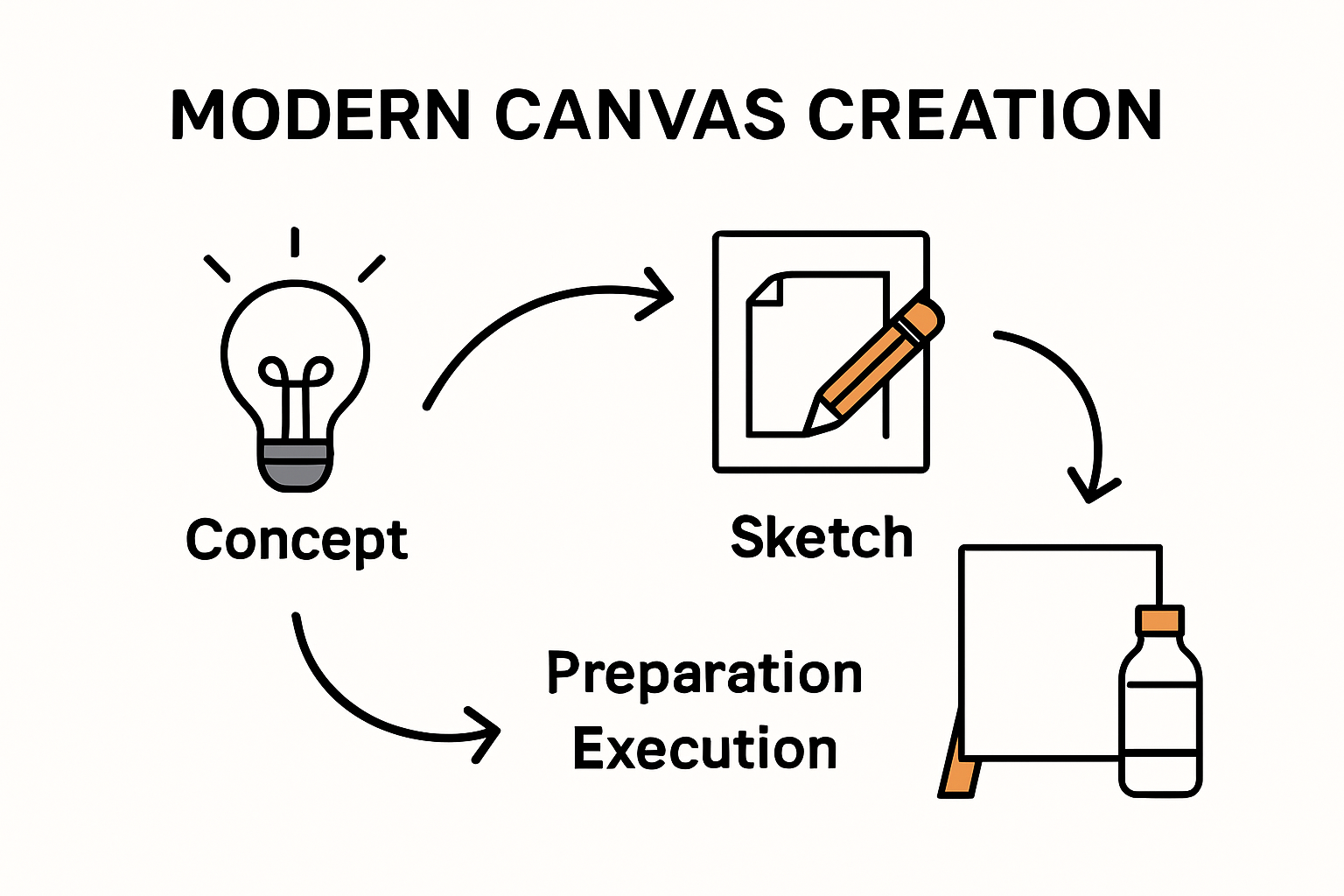 The creation of modern canvas art represents a meticulous and multifaceted process that blends traditional techniques with contemporary innovation. Artists navigate a complex journey from initial concept to final masterpiece, employing sophisticated strategies that transform raw creativity into compelling visual experiences.
The creation of modern canvas art represents a meticulous and multifaceted process that blends traditional techniques with contemporary innovation. Artists navigate a complex journey from initial concept to final masterpiece, employing sophisticated strategies that transform raw creativity into compelling visual experiences.
Conceptualization and Initial Design
Every canvas artwork begins with a profound conceptual phase where artists develop their visual narrative. Professional artists often utilize multiple approaches to crystallize their initial vision. Preliminary sketching serves as a critical foundation, allowing creators to explore compositional possibilities and experiment with potential visual arrangements.
Digital tools have revolutionized this initial stage, enabling artists to draft and modify concepts with unprecedented flexibility. Learn more about artistic design techniques that bridge traditional and modern approaches. Advanced graphic design software allows artists to manipulate color palettes, experiment with spatial relationships, and refine compositional elements before physically touching the canvas.
Material Selection and Preparation
Choosing appropriate materials represents a nuanced decision that significantly impacts the artwork’s final aesthetic and durability. Contemporary artists consider multiple factors when selecting canvas substrates: texture, weight, priming quality, and compatibility with specific painting techniques.
Modern canvas preparation involves sophisticated layering techniques. Artists apply specialized primers that enhance paint adhesion, create desired surface tensions, and optimize color vibrancy. Acrylic gesso, for instance, provides a versatile foundation that supports various painting styles, from hyper-realistic representations to abstract expressionist compositions.
Execution and Refinement
The execution phase transforms conceptual designs into tangible artworks through deliberate and intuitive creative processes. Artists employ diverse techniques ranging from traditional brushwork to experimental applications using unconventional tools like palette knives, sponges, and digital projection mapping.
Multilayered painting approaches allow artists to create depth, texture, and complex visual narratives. Each layer contributes to the artwork’s overall complexity, with artists strategically building visual information through carefully considered interventions. Color theory, spatial dynamics, and emotional resonance guide these intricate compositional decisions.
Modern canvas creation transcends mere technical proficiency. It represents a sophisticated dialogue between artistic intention, material properties, and viewer perception. Artists navigate intricate creative landscapes, transforming personal experiences and conceptual ideas into powerful visual statements that communicate beyond traditional linguistic boundaries.
The canvas becomes more than a surface. It emerges as a dynamic platform for exploring human complexity, cultural narratives, and emotional landscapes. Each artwork represents a unique journey of creative transformation, where raw inspiration is meticulously refined into compelling visual poetry.
To help visualize the step-by-step creation process of modern canvases, the following table summarizes the main stages and their specific activities:
| Stage | Key Activities |
|---|---|
| Conceptualization & Initial Design | Sketching, exploring visual narrative, digital drafts, composition planning |
| Material Selection & Preparation | Choosing canvas type/texture, applying primer (e.g., acrylic gesso), preparing surface |
| Execution & Refinement | Applying paint (various tools), layering, texture and color manipulation, final adjustments |
Techniques Shaping Abstract and Luxury Prints
Abstract and luxury prints represent the pinnacle of contemporary artistic expression, blending sophisticated techniques with cutting-edge technological innovations. These artworks transcend traditional boundaries, transforming visual experiences through intricate methodologies that challenge perception and aesthetic understanding.
Innovative Digital Manipulation Techniques
Modern abstract print creation has been revolutionized by advanced digital technologies that expand artistic possibilities. Explore premium art print collections to understand the depth of contemporary artistic techniques. According to a groundbreaking study on industrial style transfer, designers can now create remarkable visual transformations using large-scale geometric warping and content preservation techniques. This approach allows artists to manipulate visual elements with unprecedented precision, generating complex abstract representations that challenge traditional artistic boundaries.
Digital fabrication has become a critical tool in creating luxury prints. Artists now leverage sophisticated software and hardware to explore intricate design possibilities that were previously unimaginable. The intersection of computational creativity and artistic vision enables the generation of prints that possess extraordinary depth, complexity, and visual intrigue.
Color and Texture Manipulation
Color manipulation represents a crucial aspect of contemporary abstract print creation. Research published in 2020 revealed remarkable advancements in color control through nanoscale 3D printing techniques, which enable artists to precisely manipulate hue, saturation, and brightness. These technological innovations allow for extraordinary levels of color refinement, transforming prints into nuanced visual experiences that transcend traditional artistic limitations.
Texture becomes an equally important dimension in luxury print production. Contemporary artists employ multiple strategies to create tactile and visual complexity. Layering techniques, mixed media approaches, and advanced printing technologies enable the creation of prints that invite both visual and physical exploration. The surface becomes a dynamic landscape of artistic expression, challenging viewers to engage with the artwork beyond conventional visual perception.
Reproduction and Technological Precision
The reproduction of artistic works has undergone a profound transformation through technological innovations. A 2019 research paper demonstrated an integrated system capable of capturing and fabricating the gloss, color, and topographical nuances of paintings through advanced 3D printing technologies. This approach ensures that luxury prints maintain the intricate details and emotional resonance of original artworks.
Modern print techniques blur the boundaries between original creation and reproduction. Artists and technological experts collaborate to develop methods that preserve artistic integrity while exploring new modes of visual representation. The result is a dynamic ecosystem where technological precision meets creative imagination, producing prints that are simultaneously reproducible and uniquely expressive.
Abstract and luxury prints emerge as sophisticated visual narratives that communicate complex emotional and conceptual landscapes. They represent more than mere decorative objects. These artworks are intricate explorations of human perception, technological potential, and artistic vision. Each print becomes a carefully crafted experience that invites viewers to engage with art in profound and transformative ways.
How the Artistic Process Adds Value for Collectors
The artistic process transcends mere visual creation, representing a sophisticated mechanism that significantly enhances an artwork’s intrinsic and economic value. For contemporary art collectors, understanding this complex journey transforms canvas acquisitions from simple decorative purchases into meaningful cultural investments.
The Narrative of Creation
Explore contemporary art collection strategies to understand how artistic narratives influence value. According to research on art collection investment decisions, the scarcity and unique artistic journey behind a piece dramatically impact its market attractiveness. Artistic provenance emerges as a critical factor, where the documented creative process becomes as valuable as the artwork itself.
Each brushstroke, conceptual iteration, and intentional design choice contributes to an artwork’s comprehensive narrative. Collectors are increasingly interested not just in the final visual result, but in the intellectual and emotional trajectory that birthed the piece. This deeper appreciation transforms art collecting from a transactional experience into an intellectual and emotional engagement.
Authenticity and Valuation Dynamics
Authenticity represents a fundamental aspect of an artwork’s value. Research from Northern Trust emphasizes that an artwork’s genuine provenance, condition, and documented creative process directly influence its economic and cultural worth. The meticulous documentation of an artwork’s genesis provides collectors with transparent insights into its historical and artistic significance.
Modern collectors approach art acquisition as a sophisticated form of cultural investment. They seek artworks that not only possess aesthetic appeal but also demonstrate rigorous creative methodology. The artistic process becomes a form of intellectual property, where each developmental stage contributes to the artwork’s overall narrative and potential future value.
Cultural and Economic Ecosystem
Large art collectors play a pivotal role in shaping artistic markets and cultural trends. Academic research reveals that these collectors are motivated by a complex interplay of aesthetic appreciation and economic considerations. Their collecting practices influence not just individual artwork values but broader artistic ecosystems.
The artistic process adds multilayered value beyond monetary considerations. It represents a complex dialogue between creative intention, technological innovation, cultural context, and personal expression. For collectors, acquiring an artwork means participating in a broader narrative of human creativity and cultural evolution.
Ultimately, the artistic process transforms canvas prints from passive visual objects into dynamic cultural artifacts. Each artwork becomes a testament to human imagination, technological capability, and the intricate journey of creative expression. Collectors are not merely purchasing an image but investing in a profound narrative of human potential, where every artistic decision contributes to a larger, more nuanced story of cultural and personal significance.
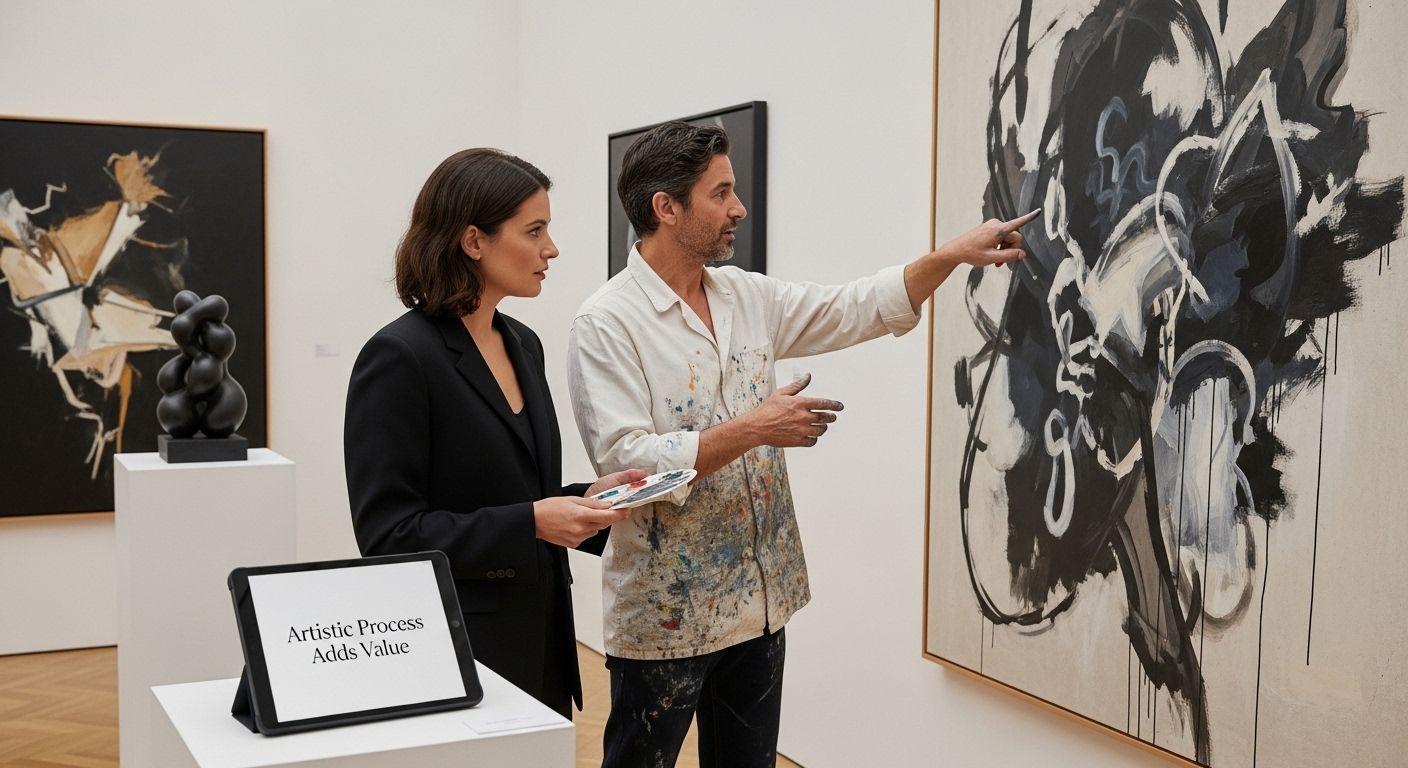
Frequently Asked Questions
What is the importance of inspiration in the artistic process?
Inspiration is crucial because it transforms abstract thoughts into tangible visual narratives, fueling creativity and artistic expression.
How do modern technologies influence canvas art creation?
Modern technologies enhance the artistic process by providing digital tools for conceptualization, material selection, and innovative techniques for executing artwork.
Why is the narrative of creation significant for art collectors?
The narrative of creation adds intrinsic value to artworks by providing insights into the artist’s process and intentions, making the artwork more meaningful and collectible.
What factors contribute to the value of contemporary canvas art?
The value of contemporary canvas art is influenced by authenticity, the artist’s creative process, and the emotional and cultural significance of the artwork.
Transform Inspiration Into Lasting Beauty: Experience Artisan Canvas Art for Your Space
Are you fascinated by the hidden steps and creative energy that define every modern canvas? If the article resonated with your passion for genuine artistry and the desire to own pieces shaped by both traditional skill and cutting-edge innovation, Marta Ellie’s collections deliver exactly what today’s art lovers crave. Each work from our Home Renovation Celebration Art collection captures the same emotional intensity and attention to process that you just discovered. These canvases are perfect for anyone looking to bring the narrative of creation and modern inspiration into their own home or office.
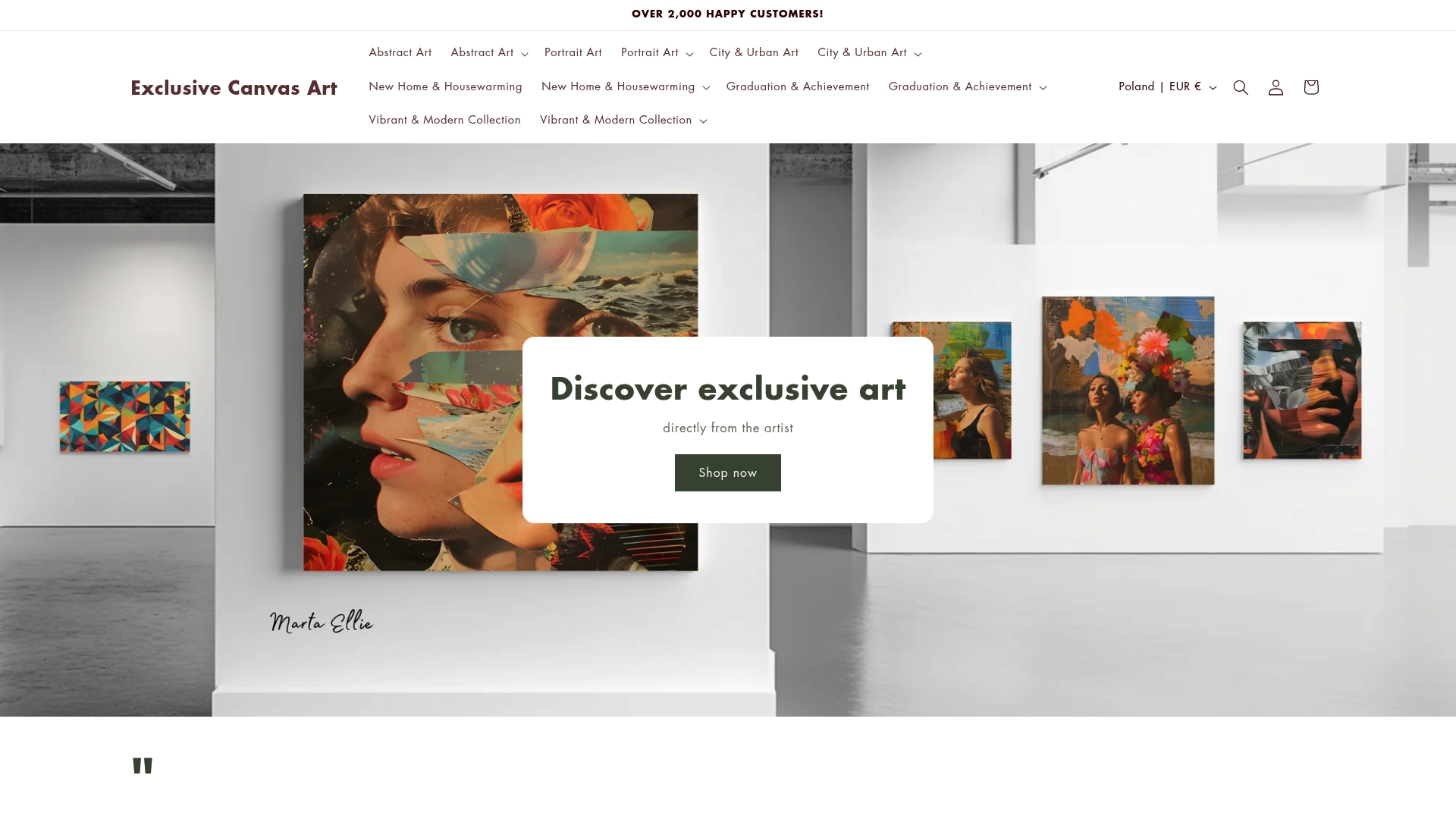
Ready to surround yourself with art that inspires and tells a story? Explore the newest exclusive collections at Marta Ellie’s online gallery. Choose the canvas that fits your life and see your walls become a daily source of creative motivation. Shop now for original, high-quality canvas prints that turn the artistic process into a visual experience you can cherish.
Recommended
- How Art Inspires Creativity: Ideas for Modern Spaces 2025 – Exclusive Canvas Art
- Canvas Art Meaning: Modern Decor & Artistic Value in 2025 – Exclusive Canvas Art
- Why Collect Contemporary Art: Value, Decor, and Inspiration 2025 – Exclusive Canvas Art
- Contemporary Art Influences: Trends Designers Love in 2025 – Exclusive Canvas Art
- Gallery Presentation Ideas for Creatives in 2025 - Webflow HTML website template
- Wedding Painting Inspiration 2025: Unique Art Ideas for Your Spanish Celebration – Live Wedding Painters